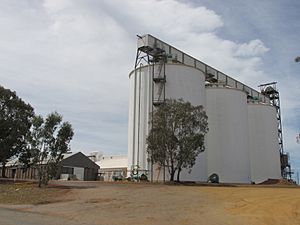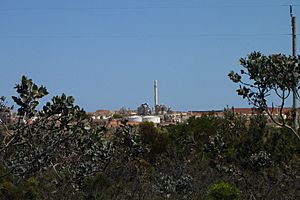Ravensthorpe, Western Australia facts for kids
Quick facts for kids RavensthorpeWestern Australia |
|||||||||||||||
|---|---|---|---|---|---|---|---|---|---|---|---|---|---|---|---|

Ravensthorpe Community Centre, formerly the Freemasons Hotel, built 1906
|
|||||||||||||||
| Postcode(s) | 6346 | ||||||||||||||
| Elevation | 232 m (761 ft) | ||||||||||||||
| Area | [convert: needs a number] | ||||||||||||||
| Location | |||||||||||||||
| LGA(s) | Shire of Ravensthorpe | ||||||||||||||
| State electorate(s) | Roe | ||||||||||||||
| Federal Division(s) | O'Connor | ||||||||||||||
|
|||||||||||||||
|
|||||||||||||||
Ravensthorpe is a town in Western Australia. It is located about 541 kilometers (336 miles) southeast of Perth. The town is also 40 kilometers (25 miles) inland from the south coast. Ravensthorpe is the main town for the Shire of Ravensthorpe. In 2021, about 2,085 people lived there.
In 1848, a surveyor named John Septimus Roe explored this area. He named many places, including the Ravensthorpe Range. The town later got its name from this range. A railway line also connected Ravensthorpe to Hopetoun. This train line opened in 1909.
Gold was found near the Phillips River in 1892. This discovery led to a small town growing there, called Phillips River. In 1906, a smelter was built to process copper and gold. This helped turn the raw metals into ingots.
Contents
History of Ravensthorpe
In 1868, a family named Dunn started sheep farming in the area. They began at a property called Cocanarup, which is west of the current town. By 1873, they had a permanent lease for their farm.
By 1901, more than 1,000 people lived in the area. The government officially named the town Ravensthorpe. The town grew quickly, and by 1909, over 3,000 people lived there. However, this growth did not last long. World War I caused many problems for the town. By 1918, the copper smelter and many mines had closed. The town's population dropped to about 800 people by 1968.
Farming in Ravensthorpe
After World War I, Ravensthorpe continued to thrive by supporting local farms. Farming in the area grew, especially after the Great Depression. More land was opened for farming in the 1960s and 1970s.
Today, the farms around Ravensthorpe grow wheat and other cereal crops. The town is an important place for collecting grain. Cooperative Bulk Handling has a grain collection site here. A large bin for wheat was built in 1947. It could hold over 30,000 bushels of grain.
Mining in Ravensthorpe
Mining has always been a big part of Ravensthorpe's story.
Nickel Mining
The Ravensthorpe Nickel Mine is a major mining site. In 2002, BHP Billiton started studying the idea of opening a nickel and cobalt mine. This mine and processing plant would be 35 kilometers (22 miles) east of the town.
The project was approved in 2004, and construction began soon after. The plant, called the Ravensthorpe Nickel Project, started working in late 2007. The first nickel was produced in October 2007. By December 2007, 5,000 tonnes had been made. The plant officially opened in 2008.
In January 2009, BHP Billiton stopped production at the mine. This was because world nickel prices dropped due to a global economic crisis. This decision led to 1,800 job losses. It had a big impact on the local economy.
In December 2009, BHP sold the mine to First Quantum Minerals. This company planned to restart the mine in mid-2011. In 2017, the mine was put on hold again because of low nickel prices. Production started again in January 2020. First Quantum Minerals later sold a part of the mine to POSCO in 2021.
Lithium Mining
The Mt Cattlin mine is located about 2.2 kilometers (1.4 miles) north of Ravensthorpe. This mine produces spodumene and tantalite. These are minerals used to make lithium. Galaxy Resources operated the mine from 2009 to 2012. It was then put on hold until production restarted on March 31, 2016. In January 2017, the first shipment of lithium concentrate was sent from Esperance to China.
Copper Mining
The Ravensthorpe Copper Mine also operated in the area in the 1960s. In 1967, the mine produced 3,276 tonnes (3,224 long tons) of copper concentrate. This concentrate contained about 23% copper. It was then trucked to the port of Esperance. From there, it was shipped to Japan.
Climate in Ravensthorpe
Ravensthorpe has a semi-arid climate. This means it is quite dry. It also has a Mediterranean rainfall pattern. This means it gets most of its rain in winter.
| Climate data for Ravensthorpe | |||||||||||||
|---|---|---|---|---|---|---|---|---|---|---|---|---|---|
| Month | Jan | Feb | Mar | Apr | May | Jun | Jul | Aug | Sep | Oct | Nov | Dec | Year |
| Record high °C (°F) | 45.4 (113.7) |
45.9 (114.6) |
41.6 (106.9) |
38.2 (100.8) |
33.9 (93.0) |
26.0 (78.8) |
26.1 (79.0) |
29.5 (85.1) |
33.0 (91.4) |
38.1 (100.6) |
42.1 (107.8) |
43.3 (109.9) |
45.9 (114.6) |
| Mean daily maximum °C (°F) | 29.0 (84.2) |
28.4 (83.1) |
26.6 (79.9) |
23.7 (74.7) |
20.0 (68.0) |
17.2 (63.0) |
16.3 (61.3) |
17.3 (63.1) |
19.5 (67.1) |
22.5 (72.5) |
25.1 (77.2) |
27.2 (81.0) |
22.7 (72.9) |
| Mean daily minimum °C (°F) | 14.1 (57.4) |
14.6 (58.3) |
13.6 (56.5) |
11.8 (53.2) |
9.6 (49.3) |
7.9 (46.2) |
6.8 (44.2) |
6.7 (44.1) |
7.4 (45.3) |
9.1 (48.4) |
11.1 (52.0) |
12.8 (55.0) |
10.5 (50.9) |
| Record low °C (°F) | 5.9 (42.6) |
5.6 (42.1) |
3.3 (37.9) |
3.3 (37.9) |
1.3 (34.3) |
−0.5 (31.1) |
−1.0 (30.2) |
−0.1 (31.8) |
0.0 (32.0) |
1.2 (34.2) |
2.1 (35.8) |
4.3 (39.7) |
−1.0 (30.2) |
| Average precipitation mm (inches) | 25.0 (0.98) |
24.6 (0.97) |
33.0 (1.30) |
33.0 (1.30) |
44.2 (1.74) |
43.7 (1.72) |
47.3 (1.86) |
44.9 (1.77) |
42.1 (1.66) |
38.2 (1.50) |
30.7 (1.21) |
24.2 (0.95) |
427.3 (16.82) |
| Average precipitation days | 5.8 | 5.8 | 7.7 | 8.4 | 10.9 | 12.3 | 13.3 | 12.9 | 11.4 | 10.0 | 7.5 | 6.0 | 112.0 |
| Average relative humidity (%) | 47 | 48 | 49 | 51 | 56 | 60 | 58 | 56 | 51 | 48 | 47 | 45 | 51 |




